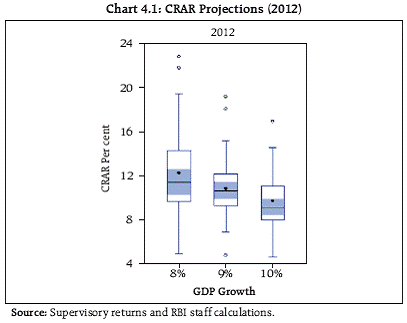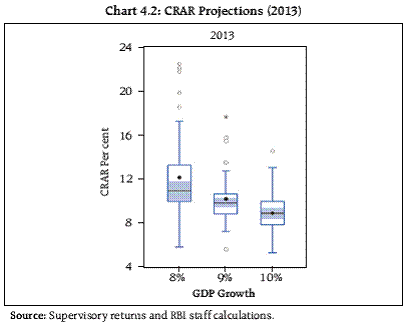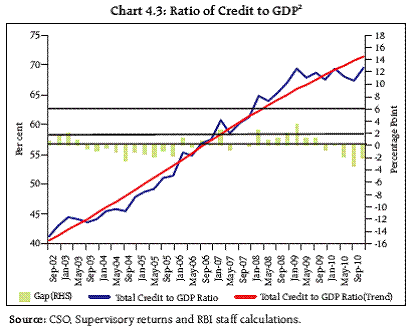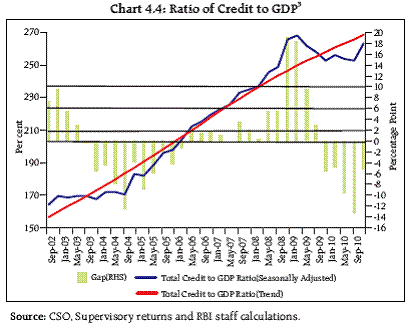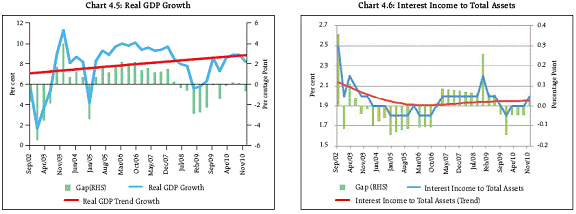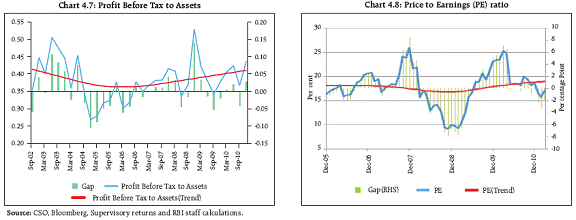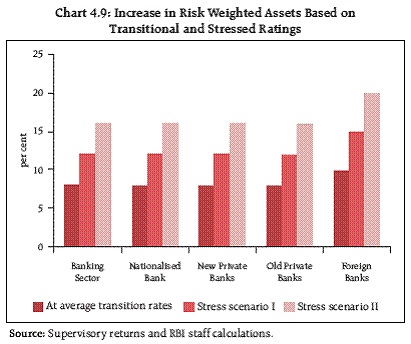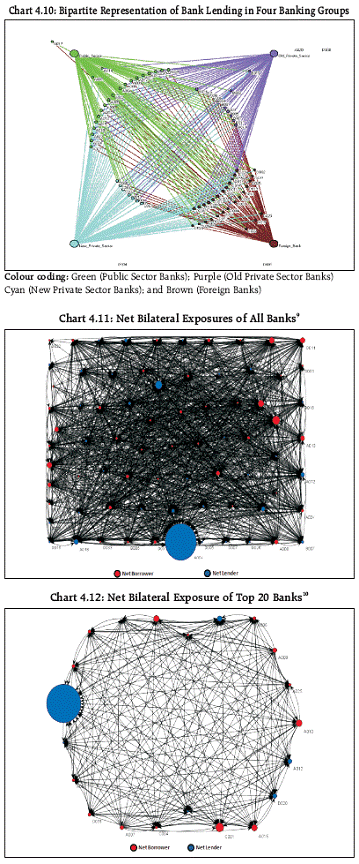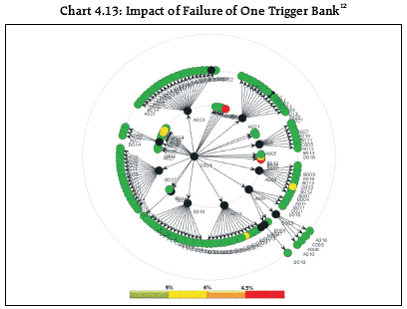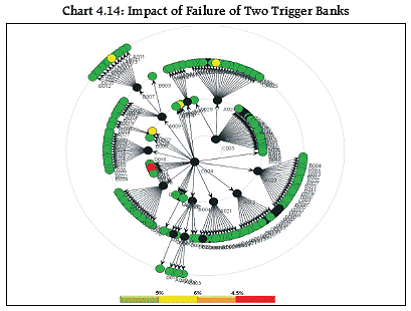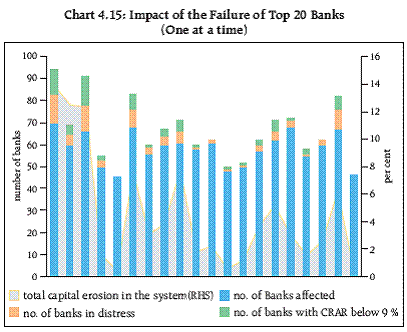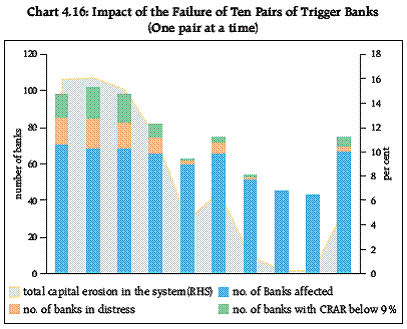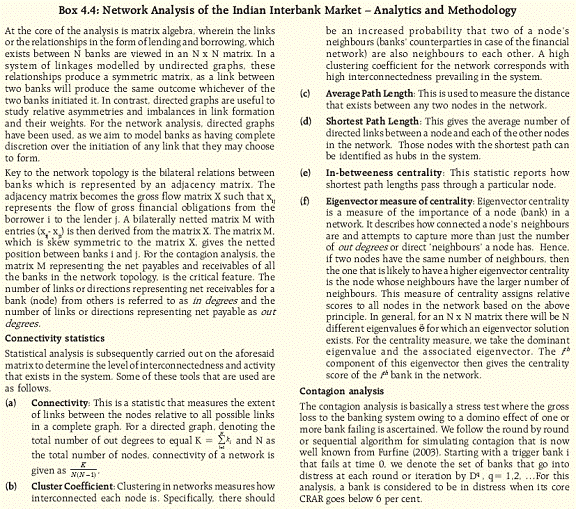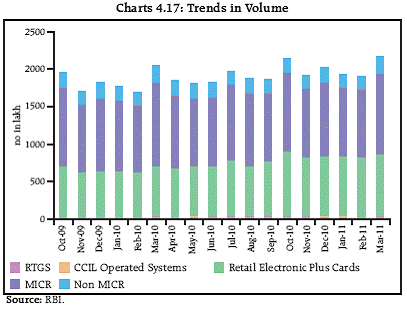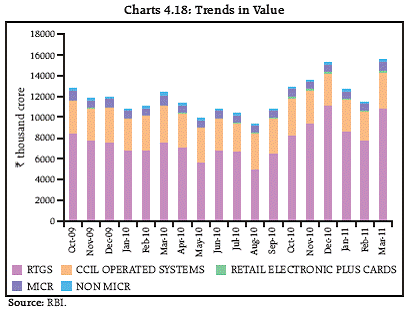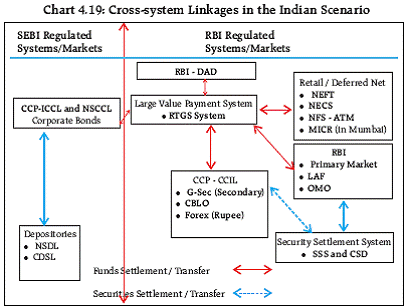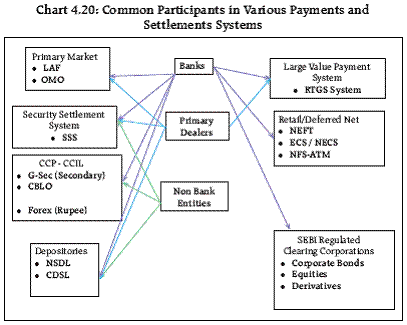 IST,
IST,
Chapter IV : Financial Sector Policies and Infrastructure
Sound regulatory policies, robust arrangements for regulation of the financial system and smoothly functioning financial market infrastructure are critical building blocks for financial stability. In 2013, the phase-in period for Basel III measures commences. Efforts are already underway to migrate to advanced approaches under Basel II. Regulators and banks across the world, and especially in emerging markets like India, will face immense challenges in the days ahead. A few individual banks may need to raise additional capital. All banks will have to gear themselves for the demanding data and analytical requirements for the revised liquidity framework and for the advanced approaches under Basel II. Even as the supervisory framework for financial conglomerates is being strengthened, the financial holding company model is being proposed as the preferred model for large financial entities in the country. Arrangements for cross border supervisory cooperation are being strengthened in a bid to reduce the probability of a crisis. Regulatory gaps, especially in the NBFC sector, leave scope for arbitrage even as financial sector laws are being revamped and banking sector legislations amended to fortify the regulatory structure. Gaps in the regulatory arrangements for the cooperative sector enabling cooperative societies to raise deposits, including from external sources, without being subject to prudential norms needs to be addressed. While the Sub-committee of the Financial Stability and Development Council (FSDC) is expected to evolve as the more active, hands-on body for financial stability in normal times, the FSDC would have a broad oversight and assume a central role in times of crisis. The network of bilateral exposures of Indian banks is highly intertwined increasing risks of a contagion from the failure of any bank(s). Caps on interbank exposures limit the domino effect, but the network of connectivities needs to be continuously monitored. Payment and settlement systems in the country are robust, but are characterised by a significant degree of interdependencies which leave them vulnerable to idiosyncratic shocks. Safety net arrangements need to address critical issues in respect of adequacy and management of funds, coverage, recovery performance and time taken for settlement. 4.1 The financial crisis that began in 2007 has revealed the need for a new supervisory and regulatory approach designed to strengthen the system and contain the risk of future financial and economic disruptions. The approach needs to be of a macroprudential nature, since recent events have shown that even rational choices at the individual level can lead to negative systemic consequences. In fact, better regulation, an effective regulatory architecture, efficient financial market infrastructure and robust analysis of data and information to identify burgeoning risks are key critical ingredients for ensuring financial stability. 4.2 The first part of the Chapter presents the current challenges as the Indian banking system attempts to migrate to the advanced approaches under Basel II and readies itself for the requirements of Basel III. It also highlights the regulatory efforts underway to strengthen and improve financial sector policies. The second part of the Chapter presents the emerging issues in the arrangements for the regulation of the financial sector in the country, highlights gaps in the regulatory perimeter and flags avenues for regulatory arbitrage. The third part presents the results of an extensive modeling exercise undertaken to analyse the network of interbank exposures in the Indian banking system. Risks and vulnerabilities in the payment and settlement systems and the safety net arrangements are presented in the last part of the Chapter. FINANCIAL SECTOR POLICIES 4.3 Significant progress has been made in crystallising the global regulatory reforms agenda which was set in motion with a view to strengthen the resilience of the banking sector and to removing the fault lines which permitted the cyclical build up of risks. These were outlined in the previous FSR. The Reserve Bank remains committed to adoption of internationally agreed standards and reforms and efforts are ongoing to this end. Domestic initiatives to strengthen the regulatory framework of the financial sector continued in parallel with several measures - increasing specific provision requirements for non-performing assets, imposition of a prudential cap on banks’ investments in debt oriented mutual funds, amongst others, being announced. Going forward, several challenges remain viz., migration to advanced approaches under Basel II, adoption of Basel III proposals for capital, liquidity and leverage, calibration of the countercyclical buffer, convergence with the revised accounting standards, etc., which are likely to test both the regulators and the regulated entities in the days to come. Higher capital requirements under Basel III 4.4 Collectively, the new global standards to address both firm-specific and broader, systemic risks have been referred to as “Basel III”, the building blocks of which were highlighted in the previous FSR. It had postulated that, given the comfortable capital adequacy position of banks in India, the Indian banking system is unlikely to be unduly stretched in meeting the more stringent requirements of the Basel III proposals. It was also highlighted that for emerging economies like India, the implementation comes at a time when credit demand is expected to pick up given, inter alia, the compulsions of robust growth, the investment needs of infrastructure and the demand ushered in by increasing financial inclusion. Thus, notwithstanding the current position at the aggregate level, a few individual banks may need to augment their capital. 4.5 An internal study shows that this is, indeed, the case. A series of regression analyses were conducted to project risk weighted assets and capital adequacy of banks under different growth scenarios and assuming a conservative growth rate of capital funds through internal accruals at 15 per cent per annum. The analysis revealed that the capital adequacy ratios of several banks fall below the minimum regulatory requirements, even under a Basel II scenario, indicating that capital will need to be augmented in the coming years (Charts 4.1 and 4.2)1. This could prove to be a challenge for the banking system, given the sluggish performance of the equity markets and could also put pressure on Government finances. The capital needs of banks will also be impacted due to the unamortised portion of pension liabilities to be absorbed by April 01, 2013 on migration to International Financial Reporting Standards (IFRS).
Calibration of a countercyclical buffer presents challenges 4.6 The Basel III proposals contemplate two capital buffers for the banking system – a capital conservation and a countercyclical buffer (Box 4.1). The calibration of the countercyclical buffers proposed under Basel III poses a number of challenges. The primary aim of the buffer is to achieve the broader macroprudential goal of protecting the banking sector from periods of excess aggregate credit growth which are often associated with the build-up of systemic risks. The regulatory authorities in each jurisdiction will, therefore, be required to monitor credit growth and make assessments of whether such growth is excessive and/or is leading to the buildup of systemic risks. Based on this assessment, they will need to use their judgment to determine whether a countercyclical buffer requirement should be imposed, to what extent it should be imposed and when the requirement should be removed. Credit-to-GDP gap may not be a reliable indicator for calibrating the buffer 4.7 The common reference guide suggested by the Basel Committee is based on the aggregate private sector credit-to-GDP gap. This indicator does not work well in all jurisdictions at all times. This is especially so in emerging economies like India, where it tends to rise for structural reasons – higher credit off take due to higher growth and greater financial inclusion. Also, some economic sectors are relatively new in India and banks have only recently begun financing them in a big way. The risk build-up, if any, in such sectors cannot accurately be captured by this ratio. Box 4.1: Capital Buffers Proposals Under Basel III Capital Conservation Buffer: The purpose of the conservation buffer is to ensure that banks maintain a buffer of capital that can be used to absorb losses during periods of financial and economic stress. While banks are allowed to draw on the buffer during such periods of stress, the closer their regulatory capital ratios approach the minimum requirement, the greater the constraints on earnings distributions. This framework will reinforce the objective of sound supervision and bank governance and address the collective action problem that has prevented some banks from curtailing distributions such as discretionary bonuses and high dividends, even in the face of deteriorating capital positions. The capital conservation buffer aims to establish a fixed range above the Common Equity Tier 1 minimum capital requirement of 4.5 per cent of Risk Weighted Assets (RWA). This buffer above the regulatory minimum requirement will be calibrated to a maximum of 2.5 per cent and has to be met with common equity, after the application of deductions. Hence, the total common equity requirements reach a level of 7 per cent. The capital conservation buffer will be phased in between 1 January 2016 and year end of 2018, becoming fully effective on 1 January 2019. It will begin at 0.625 per cent of RWAs in January 2016 and increase each subsequent year by an additional 0.625 percentage points, to reach its final level of 2.5 per cent of RWAs on 1 January 2019. However, individual countries have the discretion to impose shorter transition periods. Countercyclical Buffer: The countercyclical capital buffer works on the principle of extending the size of capital conservation buffer during periods of excess credit growth. The purpose of the countercyclical buffer is to achieve the broader macroprudential goal of protecting the banking sector from a system wide build up of risk due to excess aggregate credit growth and to ensure that the banking sector in aggregate has the capital on hand to help maintain the flow of credit in the economy without its solvency being questioned, when the broader financial system experiences stress after a period of excess credit growth. Countercyclical buffers will be calibrated in the range of 0 to 2.5 per cent of RWAs. Deviations from the trend of the ratio of private credit to GDP is the indicator preferred by the Basel Committee for gauging excessive credit growth, but countries will also need to consider other variables like asset prices, funding spreads and CDS spreads, credit condition surveys, real GDP growth, etc. while also exercising a considerable degree of judgment in deciding on the application or release of the countercyclical buffer. A lead time of up to 12 months will be given to banks when the buffer is imposed. The release of the buffer can be allowed gradually in situations where credit growth slows and system-wide risks recede in a benign fashion. References : Basel III: A global regulatory framework for more
resilient banks and banking systems, Dec 2010
4.8 An assessment of the indicator in the Indian context (using both annualised and non-annualised GDP data) shows that reliable and timely signals in respect of imposing and removing the buffers are not thrown up in a consistent manner (Charts 4.3 and 4.4). In the first case, the deviations from trend are not significant enough to guide such decisions while in the second case, the gap is volatile making it difficult to draw conclusions.
A mix of quantitative and qualitative indicators will have to guide the calibration of the buffer 4.9 An examination, in the Indian context, of some of the other possible indicators suggested by the Basel Committee reveal that none of these indicators can be, on a standalone basis, considered reliable indicators for the calibration of the countercyclical buffer (Charts 4.5 to 4.8). The calibration of the buffer in the Indian context will, therefore, have to rely on a mix of qualitative and quantitative indicators and will require a considerable degree of judgment. Further, in India, sectoral approaches to countercyclical policies have stood the test in the past. The tools used in India to contain procyclicality are essentially time-varying provisioning for standard assets and differentiated risk weights for sensitive sectors.
Migrating to higher approaches under Basel II presents many challenges 4.11 The time schedule for implementation of advanced approaches under Basel II was notified by the Reserve Bank. The guidelines for the implementation of the Internal Models Approach for market risk were released in April 2010. Guidelines on the Standardised Approach /Alternate Standardised Approach for operational risk were issued in March 2010 while those for Advanced Measurement Approach for operational risk were issued in April 2011. The guidelines on Internal Ratings Based Approach for credit risk are being formulated. Migration of banks to advanced approaches would be contingent on an internal assessment of their preparedness for the purpose and the prior approval of the Reserve Bank. Banks in India have the option of adopting the advanced approaches for one or more of the risk categories and it would not be necessary to adopt the advanced approaches for all the risk categories simultaneously. 4.12 Migration to advanced approaches under Basel II norms will facilitate a closer alignment of capital requirement with the risk profile of banks, improved quantification of Pillar II risks and enhanced monitoring and reporting processes. The process of migration, however, comes with inherent challenges. The foremost constraint is the availability of skilled personnel and robust data, especially in case of credit and operational risks. Internal rating systems to support the quantification of default and loss estimates, calibration of the exposure at default (EAD) and loss estimates to downturns and validation of risk models are integral to the advanced approach for credit risk. These systems require a large time series data, understanding of credit cycles and quantitative modeling of macro and micro level risk factors. On the other hand, operational risk modeling is a relatively new discipline and the methodologies are still evolving. Credit risk capital under the standardised approaches: Reliance on credit rating agencies will continue 4.13 The previous FSR pointed out that the reliance of banks on external ratings for arriving at their capital requirements using the Standardised Approach under Basel II is likely to continue in many jurisdictions, including India, for some time. An empirical study to assess the adequacy of credit risk capital for the rated portfolio of banks was undertaken4. Risk weights were assigned based on a rating transition matrix including stressed transitions (stress scenarios envisaged a 50 per cent (Scenario 1) and 100 per cent (Scenario II) increase in downgradations). The analysis revealed that the risk weighted assets increased by up to nearly 15 per cent when calculated based on forward looking ratings (including stressed ratings) (Chart 4.9).
Supervisory framework for Financial Conglomerates (FCs) being strengthened – issues relating to resolution and interconnectedness remain germane 4.14 The previous FSR outlined the initiatives being undertaken internationally to reform policies for Systemically Important Financial Institutions (SIFIs) with a view to reducing the probability and impact of failure, improving resolution capacity and strengthening core financial infrastructures and markets. It also outlined the existing arrangements for the supervision of large FCs in India while highlighting the areas where improvements in the regulation and supervision of these large financial firms may be warranted. Issues related to the difficulties in orderly resolution of FCs and interconnectedness with the NBFC sector remain germane. While differential prudential norms may be required for FCs going forward, efforts to improve the arrangements for the supervision of these entities are already underway. The supervisory processes for the major banking groups are being strengthened: a revised offsite reporting format has been introduced to improve capturing of the group risk profile; the criteria for the identification of FCs has been revised to include off balance sheet position of banks and NBFCs; and guidelines on the corporate governance framework and management / monitoring of risks arising of intra-group transactions and exposures are being issued. The financial holding company model - the preferred model in India 4.15 The previous FSR suggested that a holding company structure for FCs may better ring fence risks in the banking sector than the bank subsidiary model currently prevalent in the country. A Working Group on the Introduction of Financial Holding Company Structure in India5 constituted by the Reserve Bank has since recommended that the financial holding company model should be pursued as the preferred model for the financial sector in India. It has recommended that a separate legislation should be enacted for the regulation of financial holding companies and that the Reserve Bank should be designated as the regulator for such companies (Box 4.2). MoUs with overseas supervisors to enhance crossborder supervisory cooperation 4.16 International initiatives underlining the importance of cross border supervisory co-operation and information sharing gain importance in view of increasing cross border operations of Indian banks and growing presence of foreign banks in India. Till recently, there was a system of informal exchange of information and supervisory cooperation with various overseas regulators / supervisors on a bilateral “need to know” basis. However, as the need to enhance and structure this system was being increasingly felt, the Reserve Bank, in consultation with the Government, decided to enter into MoUs with overseas regulators for exchange of supervisory information within the available legal framework. The first such MoU has been signed between the Reserve Bank and the China Banking Regulatory Commission (CBRC) in December 2010 and a few other MoUs are in the pipeline. REGULATORY ARCHITECTURE FSDC and its Sub-Committee – coordinated oversight for financial stability 4.17 The earlier FSRs have argued the case for central banks having a substantive role for financial stability while proposing that it cannot be an exclusive responsibility. In the Indian context, even as the Reserve Bank has implicitly been the systemic regulator in India, other financial sector regulators too have important responsibilities. Beyond the regulators, the global crisis has demonstrated the importance of the coordinating role the Government has to play, especially in times of stress. The post crisis focus on establishing an institutional mechanism for coordination among regulators and the Government has culminated in the establishment, in December 2010, of the Financial Stability and Development Council (FSDC) to be chaired by the Union Finance Minister. The FSDC is to be assisted by a Sub-Committee to be chaired by the Governor of the Reserve Bank. This structure attempts to strike a balance between the sovereign’s objective of ensuring financial stability to reduce the probability of a crisis and the operative arrangements involving the central bank and the other regulators. While the Sub- Committee is expected to evolve as a more active, handson body for financial stability in normal times, the FSDC would have a broad oversight and will assume a central role in crisis times. Box 4.2: The Bank Subsidiary Model and the Financial Holding Company Model Over the years, banks have set up subsidiaries in various nonbanking financial areas such as Mutual Funds, Housing Finance, Insurance, NBFCs, etc. This, in turn, led to the development of some large and complex financial institutions in the country, which are commonly referred to as Financial Conglomerates (FC). The emergence of FCs in India brought to the fore questions about the organisational structure of such entities, i.e. which should be the preferred corporate model for these entities. The issue acquired relevance from two distinct, though inter-related, perspectives – one, efficient corporate management within the groups addressing the growth and capital requirements of different entities; and two, the degree of regulatory comfort with different models, particularly in regard to the concerns relating to contagion risks. FCs in India, at present, are generally organised under the Bank Subsidiary Model (BSM) in which the bank is the parent of all the subsidiaries in the group. In contrast to this, a Holding Company Model (HCM), is one where commercial banking, insurance, investment banking, mutual fund, stock broking and other financial activities are conducted under the same corporate umbrella. The Working Group on the Introduction of Financial Holding Company Structure in India was mandated to examine the need and feasibility of introducing a financial holding company model in the Indian context, including by drawing lessons from the global financial crisis. The Working Group found that though the HCM is not conclusively superior to the BSM, it offers some distinct advantages, viz.,
Legislative reforms FSLRC constituted – revision to legislations in tune with the current policy framework 4.18 The Union Budget 2010 proposed the setting up of a separate Financial Sector Legislative Reforms Commission (FSLRC) to rewrite and clean up the financial sector laws. The FSLRC has since been formed under the chairmanship of Justice (Retd.) B. N. Srikrishna and has constituted eight sub-committees that will look into areas such as banking, pension, insurance, capital markets, debt management office, forward markets and legal processes. As the previous FSR argued, there is a strong case for reviewing the various legislations and recasting them in tune with the current policy frameworks. Proposed amendments to the legislative framework for banks to make regulatory powers of the Reserve Bank more effective 4.19 The Banking Laws (Amendment) Act, 2011 has been introduced in the Parliament in March 2011 seeking to amend the Banking Regulation Act, 1949, the Banking Companies (Acquisition and Transfer of Undertakings) Act, 1970 and the Banking Companies (Acquisition and Transfer of Undertakings) Act, 1980 to, inter alia, make the regulatory powers of the Reserve Bank more effective and to increase the access of the nationalised banks to capital market (Box 4.3). Non Banking Financial Sector The non-banking financial sector in India – within a regulatory ambit 4.20 Strengthening regulation and supervision of shadow banking has been identified by the G20 Leaders as a critical issue for financial sector regulation. In the Indian context, as reported in previous FSRs, the NBFC sector is not typically a shadow banking sector as in the case of advanced economies since the sector is largely regulated by the Reserve Bank, SEBI, IRDA and NHB. Money market instruments like commercial paper and short term non-convertible debentures (NCDs) are regulated by the Reserve Bank while SEBI regulates mutual funds and longer tenure NCDs. Gaps in regulation remain even as the entities continue to be closely interconnected 4.21 The previous FSR highlighted the fact that while NBFCs are subjected to prudential regulations, the regulations vis-à-vis banks is asymmetrical, with banks being subjected to more stringent regulations. It was also highlighted that the presence of multiple regulators for the NBFCs in the country and an entity based approach to regulation give rise to possible regulatory gaps. Many entities, which are borrowing both from the markets and the banks, have the capability of being over-leveraged and, being deeply interconnected, can pose systemic risks. Both banks and mutual funds also invest in corporate paper of NBFCs thereby enhancing the financial integration of these entities. Some restrictions exist on the NBFC exposures that banks can take and the Reserve Bank has recently announced a prudential cap on banks’ exposures to debt oriented mutual funds6. Several measures to tighten the regulatory framework for NBFCs have also been announced, as discussed in Chapter III of this Report. Nevertheless, these entities remain closely interconnected. 4.22 There are also differences in regulatory requirements of different NBFCs carrying on similar activities and gaps in regulation of certain entities give rise to potential for regulatory arbitrage. The previous FSR highlighted some such instances. Further, there are important differences in the regulatory requirements applicable to brokers for margin trading and those applicable to NBFCs undertaking similar activities especially with respect to requirements of minimum net owned funds, restrictions on borrowings, availability of margin trading facility for initial public offerings and other risk management prescriptions. There is also a need to bring in Alternative Investment funds including private pools of capital such as hedge funds, private equity funds, etc. within the regulatory perimeter. Further, NBFCs set up by banks to carry on activites that can be undertaken by banks presents a clear case of regulatory arbitrage both on the assets and liabilites side. Box 4.3: Main Features of the Proposed Amendments to Banking Legislations (A) The main features of the proposed amendments to the Banking Regulation Act, 1949: (i) To exempt mergers and acquisitions of the banking companies from the applicability of the provisions of the Competition Act , 2002; (ii) To confer power upon the Reserve Bank to specify approved securities; (iii) To enable banking companies to issue preference shares subject to regulatory guidelines issued by Reserve Bank; (iv) To remove the existing restrictions on voting rights limited to ten per cent of the total voting rights of all the shareholders of the banking company; (v) To provide for prior approval of Reserve Bank for acquisition of 5 per cent or more shares or voting rights in a banking company; (vi) To align the restriction on commission, etc., on sale of shares to issue price rather than to the paid-up value of shares; (vii) To confer power upon the Reserve Bank to specify the cash reserve ratio for select banks; (viii) To establish a “Depositor Education and Awareness Fund” to take over inoperative deposit accounts (accounts not claimed /operated for a period of ten years or more); (ix) To confer power upon the Reserve Bank to call for information and returns from the associate enterprises of banking companies and to inspect the same, if necessary; (x) To confer power upon the Reserve Bank to supersede the Board of Directors of a banking company in certain cases in consultation with the Central Government;(xi) Substantially increase the penalties and fine for some violations of the Banking Regulation Act; and (xii) To confer power upon the Reserve Bank to order a additional audit of cooperative banks in public interest for a more effective supervision of cooperative banks. (B) The main features of amendments proposed in the Banking Companies (Acquisition and Transfer of Undertakings) Act, 1970 and 1980: (i) Enable the nationalised banks to increase or decrease the authorised capital with the approval from the Central Government and the Reserve Bank without being limited by the ceiling of a maximum of three thousand crore of rupees; (ii) Permit the nationalised banks to issue two additional instruments (“bonus shares” and “rights issue”) for assessing the capital market to raise capital required for expansion of banking business; (iii) Raise restriction on voting rights from the existing 1% to 10 % for shareholders other than the Central Government. 4.23 A Working Group on NBFCs is, inter alia, examining issues related to regulatory gaps and identifying arbitrage opportunities that exist in the system, enhancing disclosure requirements, improved supervisory practices, etc. Systemic importance of Government sponsored NBFCs warrants their being subject to prudential regulation 4.24 There are at present 37 Government owned NBFCs (five NBFCs owned by the Central Government and 32 by various State Governments). Nine of these entities are deposit taking NBFCs, with deposits amounting to nearly ` 2,000 crore as on March 31, 2010, while the total advances of the 37 companies stood at nearly ` 2.9 lakh crore. Further, the assets of these companies have been progressively increasing over the years with funding largely through public markets. 4.25 These entities have so far been exempted from the prudential regulatory framework for NBFCs as they are under the administrative control of a ministry of the Government and because they were deemed to pose less supervisory concern with regard to protection of depositors’ interest. Over time, the systemic importance of the Government entities has increased with the expanding size of their balances sheets and their growing interaction with the financial system. At the same time, the regulatory framework for NBFCs has also acquired an explicit focus on the systemic risks posed by the sector and on regulatory arbitrage. It has, therefore, been decided to revisit the exemptions granted to these NBFCs in consultation with the Government. The regulatory framework for wealth management services warrants examination 4.26 A recent high profile fraud unearthed in the wealth management services offered by a bank in the country has thrown open a host of issues regarding the regulation of such activities and the conflicts of interest in the Indian financial sector. In the Indian context, activities related to portfolio management services (PMS) are governed by the SEBI (Portfolio Managers) Regulations and Rules, 1993. Amongst banks, one major public sector bank has been permitted to offer PMS for a few pension/ superannuation funds. Other banks are only permitted to undertake non-discretionary investment advisory service with the prior approval of the Reserve Bank. Over time, however, the distinction between offering advisory and portfolio management services has become increasingly blurred, as is evident from the aforesaid fraud. 4.27 There is, therefore, a need to revisit the entire set of regulatory prescriptions for wealth management services including formulation of regulations for investment advisers and for harmonising instructions issued by different regulators. To this end, the Reserve Bank is in the process of conducting a survey in respect of wealth management activities being provided by banks. SEBI is also considering putting in place an appropriate regulatory framework for such activities. Above all, the issue of banks selling third party products and the conflicts of interest entails greater examination. Proliferation of structured products in an unregulated space may pose systemic concerns 4.28 Structured products, in the Indian context, are being issued mainly by NBFCs in the form of debt securities with returns linked to equity, commodities etc. These products, which are issued as debentures and are typically privately placed, are currently not subject to any specific regulatory regime. They are sold mainly to High Net worth Investors through portfolio managers or through wealth management services of banks. They are complex securities where the investors may not be able to understand the underlying risks. There is also a risk involved in the ability of the issuer to create a proper hedge. As these are illiquid instruments, there are concerns relating to valuation of such instruments. While the quantum of outstanding structured products is not very significant at the current juncture, the complexity and lack of transparency of such products, their illiquidity and concerns over valuation, and their potential ability to influence asset prices through the derivatives markets may give rise to systemic concerns, especially if such products proliferate in an unregulated space. Regulatory gaps permitting deposit raising activities of cooperative societies without being subject to prudential norms need to be plugged 4.29 Banking activities of primary (urban) co-operative banks originally registered as co-operative credit societies are regulated by the Reserve Bank under the provisions of the Banking Regulation Act, 1949 (As applicable to Cooperative Societies). The provisions of the Act are not applicable to a society if the paid up share capital and reserves of a co-operative society are less than one lakh rupees and /or if the deposits accepted by the society are not repayable on demand. Under the current legal environment, therefore, a cooperative society may enroll any number of members, receive deposits from the members, raise loans and receive grants from external sources. The cap on funds raised from the external sources in the case of a cooperative society registered under the Multi-State Cooperative Societies Act is ten times of the sum of its subscribed share capital and accumulated reserves and in the case of those registered under the State Acts, the cap is prescribed in the byelaws of the society. The aforesaid position represents a regulatory gap which enables entities to raise public deposits without being subject to any prudential norms. The entire gamut of issues related to raising of funds, especially from external sources, by these entities needs to be examined. NETWORK ANALYSIS 4.30 The previous FSR underscored the importance of developing strong analytical methods that help better identify, monitor and address systemic linkages. To further study the linkages amongst the scheduled commercial banks, an Integrated Communication Technology (ICT) based network model7 has been developed to assess the degree of connectedness in the system and to analyse the possible domino impacts of bank failures. Structural aspects of the Indian interbank market 4.31 For the entire analysis, bilateral data as on December 20108 has been used. The total gross value of these exposures amounts to around ` 6.9 lakh crore. An analysis of the network of net bilateral exposures reveals that, amongst the banking groups, on the aggregate, the public sector and the old private sector banks are the net lenders in the system while the new private sector and foreign banks are the net borrowers (Charts 4.10 to Chart 4.12). The Indian banking sector– clustered and connected 4.32 The Indian banking system is found to be substantially connected and clustered. Also, as evident from the central circular formation in chart 4.10, most banks have exposures to banks in all banking groups. The system has a total of 1514 edges (i.e., an aggregate of 1514 in degrees and out degrees), a cluster coefficient of 42 per cent and connectivity of 27 per cent (Box 4.4). Contagion Analysis – A stress test scenario 4.33 The above mentioned network model of bilateral exposures can be used to model the impact of bank failures. The contagion analysis (Box 4.4) works on the basic principle that all net lenders to a failing bank (trigger bank at the centre of the contagion chart) will get affected in the first round of contagion. Banks which come under distress11 from an idiosyncratic event causing the failure of the trigger bank(s) will always have the potential to cause further damage in subsequent rounds of contagion. The contagion eventually ends when the system absorbs all the losses generated (Chart 4.13 and 4.14). 4.34 The impact as the result of failure of top 20 most connected banks, one at a time, and that of the failure of 10 pairs of banks, one pair at a time, are presented in Charts 4.15 to 4.16. 4.35 The above analysis clearly demonstrates the intertwined nature of the banking system in the country and leaves the system vulnerable to domino effects in case of idiosyncratic failure of one or more banks. The impact of such failures, in this model, would depend on how connected the bank is to other banks in the system as also its relationship with other banks (e.g. lender or borrower). The above analysis shows that the failure of the most connected bank in the system shaves off nearly 14 per cent of the banking system’s core capital. The contagion impact is relatively contained due to regulatory limits on interbank exposures (e.g. limits on cross holding of capital amongst banks, limits on call money market exposures and prudential limits on interbank liabilities). The impact could be further aggravated if other entities in the financial system (other banks, NBFCs, Mutual Funds, etc.) are brought within the ambit of analysis. In any case, there remains need for continuous monitoring of the interconnectivities in the financial system to identify build up of risks/excesses in the system and to guide policy action to address the same.
PAYMENT AND SETTLEMENT SYSTEMS Regulatory arrangements for payment and settlement systems 4.36 In India, the Reserve Bank is tasked with the regulatory oversight of the payment and settlement systems in the country. The legal framework for the oversight role of the Reserve Bank is provided by the Payment and Settlement Systems (PSS) Act, 2007 and the Payment and Settlement System Regulations, 2008 framed there under. Commodity spot exchanges – a gap in the perimeter of regulation 4.37 The previous FSR also outlined some of the gaps in regulatory perimeter, in particular, the fact that some payment systems viz., stock exchanges and clearing corporations set up under stock exchanges, remain outside the purview of the PSS Act. Also important in this connection is the functioning of the spot commodity exchanges. These exchanges facilitate purchase and sale of specified commodities, including agricultural commodities, metals and bullion by providing spot delivery contracts in these commodities. This market functions like the cash segment in equities and provides facilities such as clearing and settlement of trades on guaranteed multilateral netting basis. At present, there are four such exchanges functioning in the country. 4.38 An issue arises in the context of the clearing and settlement services offered by the spot exchanges which are currently not regulated under the PSS Act, 2007 or under any other regulatory arrangement. Operational performance of the payment and settlement systems Operational Performance remains robust 4.39 The operational performance of the payment and settlement infrastructure in India continues to be robust with no major disruptions to the payment and settlement process (Charts 4.17 and 4.18).
Progress in migration to electronic clearing modes continued 4.40 Paper based payment instruments continued to be widely used with their share in the Indian payment system constituting 59 per cent in terms of volume. However, in terms of value, their share was only 10 per cent. Recent initiatives such as the introduction of time window for hourly settlement of NEFT transactions, the introduction of a system of positive confirmation to the beneficiary, extending NEFT to Regional Rural Banks (RRBs) and reducing the settlement cycle of ECS operations are aimed at expanding the reach of electronic clearing systems and can be expected to facilitate further migration of transactions to the electronic mode. Operational risks closely managed and vulnerabilities monitored 4.41 Management of operational risks in payment and settlement systems has been a key priority for the Reserve Bank. The Reserve Bank has three data centres – two on-city (Mumbai) and one off-city - which ensure that sufficient redundancies are available in case of any disaster at any critical region/installation. Regular disaster recovery drills test the resilience of the systems. Live operations of the payment and settlement systems were carried out from the off city centre on three occasions during the half year ended March 31, 2011. The member institutions participated in the drills from their primary sites. Issues such as slow network response /intermittent connectivity loss in some centres, revealed by the drills, were taken as feedback for necessary follow up/ corrective action. 4.42 Vendor concentration was observed in some of the activities like hardware and software maintenance in the core banking solutions being used by scheduled commercial banks and in certain ATM services outsourced by banks. Settlement of large value transactions 4.43 For the management of settlement and other risks in payment and settlement systems in the country, the approach adopted by the Reserve Bank has been to migrate the settlement of all large value transactions to the Real Time Gross Settlement (RTGS) system or to deferred net settlements. For most critical systems, the settlement takes place on guaranteed basis through a central counterparty (CCP). While Clearing Corporation of India Limited (CCIL) acts as the CCP for money, government securities and foreign exchange markets in the country, there are other CCPs for equity and commodity markets. The previous FSR outlined several issues of concern with respect to the functioning of the CCIL including that of the design of CCIL as a multiproduct CCP, absence of a net debit cap in the CBLO segment, Herstatt risk in foreign exchange settlement, etc. A number of steps have been initiated to further strengthen the extant risk management practices in various segments including operationalisation of a default fund for the forex forward segment and imposition of intra-day mark to market margin in the securities segment. Liquidity risks for CCPs in India remain – need to be addressed 4.44 Liquidity risk is one of the major risks faced by CCPs. This has also been highlighted in a recent report on “Principles for financial market infrastructure”13 which recommends that a CCP should effectively measure, monitor, and manage its liquidity risk. In fact, most well managed CCPs have developed various lines of defence– in the form of member margins, guarantee funds, non-member commitments and its own capital – to manage liquidity risks. There remains, however, the potential risk of a CCP default especially as the lines of defence may not be adequate in times of system wide stress. In any case, there are vulnerabilities arising from, inter alia, the quality of collateral being accepted by the CCP; competitive pressures leading to CCPs being incentivised to lower initial margins, accept a wider range of collateral or allow lower haircuts; and the inherent model risks arising from models which are relied on to produce valuations on which the margining system is based. 4.45 Some of these risks are evident in the Indian system as well, though CCPs in India are subject to a fair degree of regulatory oversight. In the case of CCIL, which is subject to both on-site and off-site supervision, there are dependencies for settlement on committed backup liquidity for funds and securities from financial institutions which are important market players and may not be able to provide the backstop liquidity during times of systemic stress. In the case of other CCPs operating in the country (for example the CCPs in the equity markets), there are vulnerabilities arising out of exposures to the banking sector as collateral in the form of bank deposits, bank guarantees, etc. are accepted in lieu of margins and contribution to guarantee funds. In any case, the collateral damage from the failure of a CCP, however unlikely, is too large for these risks to be left unaddressed. Access to central bank liquidity is one option; private sector bail in mechanisms could be explored 4.46 The concerns in respect of liquidity risks of CCPs raise the issue of access of the CCP to central bank liquidity, which was flagged in the previous FSR. The matter is far from straightforward as the very expectation of a committed central bank support may, in fact, further perpetuate the same risks on account of the classical moral hazard problem. The provision of central bank liquidity could work on a case by case basis but, even then, central banks would require that the CCP is either regulated by it or, at the very least, it has access to all the relevant information about its risk management in order to assess the case and has the authority to request CCPs to implement changes to their risk management. In the Indian case, there is a further complication that not all CCPs are regulated by the central bank under the PSS Act. 4.47 With CCPs emerging as the preferred mode for settlement of transactions globally, the risks of creating a new set of “too big to fail” institutions are greater than mere tail risks, and arguably call for efforts to enhance the private sector bail-in mechanisms for CCPs, just as is being considered for systemically important banks. OTC markets 4.48 Several issues and challenges facing the OTC markets in India, viz., skewed participation structure, greater standardisation, introduction of central clearing, etc., were highlighted in the previous FSR. These issues remain relevant especially as continuing low volumes in some derivative markets make it difficult to mandate guaranteed clearing for these markets. A central repository for all products offers several advantages but raises governance issues 4.49 A key shared priority amongst international policy makers is to ensure, inter alia, reporting of all OTC derivative products to a trade repository. Internationally, it is being argued that there should be a single repository worldwide for any given instrument. Otherwise, the aggregability of data will not be ensured and it may not be possible to get a clear picture of positions and exposures, particularly when two parties to a transaction are located in different jurisdictions. However, there is little discussion about whether there should be single repository for all products as well. Further, such repositories being public utilities, there is a strong case for them to function as “not for profit” entities. Existing reporting arrangements in the Indian context could be leveraged 4.50 Unlike in most jurisdictions, where centralised trade reporting has come into focus only post-crisis, India has had arrangements for reporting of various OTC derivative transactions ranging from summary information to transaction level data. The Reserve Bank has been working closely with CCIL to develop various modules for transaction reporting. The existing reporting arrangements for OTC markets encompass foreign exchange, interest rate, government securities, corporate bonds and money market instruments. What is now needed is a consolidation of the reporting arrangements. Since CCIL has already developed the requisite platforms, it seems logical to leverage the advantages of economies of scale and scope, going forward. However, as CCIL also functions as a CCP, any such arrangement will need to address the governance issues relating to separation of trade repository function from the CCP function. 4.51 In this regard, a Working Group of the Reserve Bank has made several recommendations towards expanding the menu of products which are reported and requiring such reporting through regulatory mandates. Portfolio compression – managing systemic risks in the OTC derivative markets 4.52 The financial crisis of 2007-09 exposed the potential of OTC derivatives markets to contribute to the build-up of systemic risk. In the Indian context, the size of the derivative market remains limited and the product profile continues to be largely plain vanilla. Nevertheless, there remains potential for build-up of systemic risks given that there are very few active participants. With bilaterally negotiated early terminations being the only way to exit a position (besides entering into a trade with a opposite payoff), gross notional outstanding amounts multiply manifold leading to higher capital requirements and reduced availability of counterparty limits. More importantly, the gross notional values do not capture the economic essence of the portfolios. 4.53 The preferred solution internationally – that of migration to CCP settlement – does not apply in markets/products where, for different reasons, it is not feasible to introduce such arrangements. A solution being contemplated in some quarters for these markets/products is portfolio compression - a market-wide exercise that reduces the overall notional size and number of outstanding contracts in OTC derivative portfolios without significantly altering the risk profiles of the individual portfolios. The process involves identification of trades which can be terminated early by all the counterparties such that the constraints/ tolerance limits defined by each individual participant are satisfied. In the Indian context, CCIL is currently in the process of developing trade compression services for the rupee derivatives market. Interdependencies in the payment and settlements Knock-on effects of interdependencies in payment systems could cause disruptions 4.54 The risks of increasing interdependencies in payment system infrastructures and potential knock-on effects which could affect multiple systems due to their inter-linkages were highlighted in a recent report14. In the Indian context too, payment systems and related settlement flows, operational processes and risk management procedures are becoming increasingly interdependent. This increases the possibility of disruptions in any one system affecting the smooth functioning of other related systems and elevates the risk of disruptions to the entire payment and settlement infrastructure of the country due to an idiosyncratic event affecting any single system. There is strong evidence of system and institution based interdependencies in India 4.55 Interdependencies, in the Indian context, include system based interdependencies arising from direct cross–system relationships, i.e. relationships between the Reserve Bank and CCIL operated systems, as well as with SEBI regulated clearing corporations which settle the funds leg of the corporate bond transactions in the RTGS system (Chart 4.19).
4.56 Again, there are institution-based interdependencies which result from indirect relationships between two or more systems through a common financial institution. In India, this is highly evident as all major financial institutions are participants in all systems. In addition, some major participants act as settlement banks for funds settlement for some other participants in the CBLO and government securities segments. Again, some major banks in CCIL and Reserve Bank operated systems are settlement banks for the equity markets, while some provide funds and securities lines of credit to CCIL in segments in which they are also major players (Chart 4.20).
4.57 Other forms of interdependencies also arise out of operational factors such as a financial institution acting as clearing bank for a system (as in the case of banks acting as clearing banks for the equity market CCPs) or because of providing common infrastructures (the INFINET network operated by IDRBT). A macro view of the risk management by interdependent systems is warranted 4.58 Thus, the Indian payment system is a highly integrated and interdependent web of interrelationships, as is the case with most such systems across the globe. While these interdependencies have generated their own set of synergies leading to operational efficiency and also reduced risks (for example reduced credit risk due to DVP settlement in the RTGS system), the high level of integration and interdependency affects the settlement flows between various systems. It implies that credit and liquidity risks can spread very fast throughout the system. Disruptions in the payment and settlement systems could also affect the underlying financial markets. While arrangements such as settlement of transactions in key payment systems in central bank money, introduction of CCP settlement, etc., have mitigated these risks to a great extent, there remains need for watchful management of the interdependencies. The risk management systems of each payment system have an important bearing on the overall containment of systemic risk and a macro view of these systems and their impact on systemic risk will be critical to manage the risks arising out of interdependencies in the payment systems. DEPOSIT INSURANCE 4.59 The previous FSRs highlighted the importance of a strong deposit insurance system as an integral part of financial stability arrangements in any jurisdiction. The effectiveness of safety net systems was severely tested during the recent financial crisis and a large number of countries adopted policies to enhance depositor protection with a view to strengthen public confidence in the banking system. Exit from such special arrangements is one of the main challenges facing deposit insurance systems internationally. Deposit insurance agencies in different countries are also looking into ways to enhance the effectiveness of cross-border arrangements in order to reduce the adverse impact of bank failures in the home country on the host country. Another policy initiative is aimed at providing for the proactive and early involvement of deposit insurance agencies in the resolution of weak/failing banks. Macro issues facing deposit insurance system in India remain relevant 4.60 The previous FSR highlighted several issues and challenges facing the deposit insurance system in India. These, inter alia, include ensuring the adequacy of the deposit insurance fund, reducing the time taken to reimburse depositors, improving the coverage of the deposit insurance system, broadening the mandate of DICGC to include bank resolution, and ensuring compliance with the Core Principles for Effective Deposit Insurance Systems. These issues remain relevant. Meanwhile, DICGC has initiated steps to settle longpending cases of settlement. The Corporation is also in the process of implementing an integrated claims management system aimed at improving data collection system and reducing time taken to settlement. However, one major reason for delay in reimbursing depositors - inadequate powers with the Corporation to ensure accountability of the liquidators – remains to be addressed. The fund ratio of the Corporation continues to remain low by international standards thus limiting the Corporation’s ability to enhance coverage. Addressing issues relating to broadening the mandate of DICGC, though very important, will require sweeping changes in the legislative framework. 4.61 A Working Group on Reforms in Deposit Insurance is reviewing various issues, including adequacy of deposit insurance fund, broadening the mandate of DICGC, funds management and improving recovery performance. CONCLUDING REMARKS 4.62 Significant strides have been made to strengthen the regulatory arrangements for the financial system, both internationally and domestically. Going forward, several issues and challenges are likely to emerge. Some banks may need to raise additional capital for funding credit growth and for meeting the requirements of Basel III. This may present difficulties given the sluggish performance of the equity markets. Amendments to banking sector legislations easing the access of nationalised banks to the capital market may alleviate this. Prescribed indicators for calibrating the countercyclical buffers may not be appropriate in emerging markets like India and a mix of qualitative and quantitative indicators as well as a good dose of regulatory discretion will need to be employed for calibrating the buffers. Guidelines for migration to advanced approaches under Basel II have been issued and many challenges - availability of robust data and skilled personnel, need to develop internal rating systems to support the quantification of default and loss estimates, sound stress testing processes and validated risk models, etc. - are likely to emerge. Efforts are ongoing to improve the supervisory arrangements for FCs though issues such as orderly resolution remain germane. 4.63 The structure of the FSDC and its Sub-Committee attempts to strike a balance between the sovereign’s objective of ensuring financial stability and the operative arrangements involving the central bank and other regulators. Legislative reforms to banking sector laws are expected to render the regulatory powers of the Reserve Bank more effective. Gaps in the regulatory perimeter for NBFCs and scope for regulatory arbitrage remain – a Working Group constituted by the Reserve Bank is examining the gamut of these issues. The exemption to Government sponsored NBFCs from Reserve Bank regulations needs to be revisited as the systemic importance of these entities have grown. The existing regulatory framework for wealth management activities and for structured products needs strengthening. 4.64 The Indian banking system is substantially connected and clustered, which leaves the system vulnerable to domino effects in case of idiosyncratic failure of one or more banks. 4.65 The clearing and settlement facilites offered by spot exchanges are currently not regulated in terms of the PSS Act, 2007 or under any other arrangement. Liquidity risks for CCPs in India, if they materialise, could have significant systemic impact. Access to central bank liquidity for CCPs is fraught with moral hazard risks and may necessitate efforts to enhance the private sector bail-in mechanisms for CCPs, just as is being considered for systemically important banks. A single repository for all OTC products offers several advantages. In the Indian context, existing reporting arrangements developed by CCIL for foreign exchange, interest rate, government securities, corporate bonds and money market instruments could be leveraged for the purpose. Introduction of a trade repository potentially paves the way for portfolio compression of derivative contracts with a view to reducing systemic risks. There is strong evidence of system and institution based interdependencies in the Indian payments systems implying that an idiosyncratic event affecting any single system can spread very fast throughout the entire system. 4.66 Issues related to ensuring the adequacy of the fund ratio of DICGC, reducing the time taken to reimburse depositors, improving the coverage of the deposit insurance system and broadening the mandate of DICGC to include bank resolution remain relevant and are being examined by a Working Group set up by DICGC. 1 The additional capital arrived at in the internal study represents the capital which banks will need to raise in order to maintain their capital adequacy ratios in a situation of robust credit growth which can be expected given the growth rates assumed in the study. 2 Credit includes bank credit, external commercial borrowings, corporate bonds, NBFCs-D and UCBs. GDP is taken at current market price, which is annualised based on four quarters moving sum. The trend component of credit and GDP has been extracted using the Hodrick-Prescott filter. 3 Credit includes bank credit, external commercial borrowings, corporate bonds, NBFCs-D and UCBs. GDP is taken at current market price. The trend component of credit and GDP has been extracted using the Hodrick-Prescott filter. 4 The study is based on the rating wise distribution of the portfolio of scheduled commercial banks as reported to the Reserve Bank. The study considers risk weights based on the rating distribution of the portfolio which would result if ratings migrated based on the average one year transition matrix (Transition matrix of CRISIL Ltd. has been used). For example, if 3 per cent of the AAA rated corporates are expected to migrate to AA rating, 3 per cent of the bank’s AAA rated portfolio has been risk weighted at 30 per cent (as applicable to AA rated accounts) instead of 20 per cent (as applicable to AAA rated accounts). 5 /en/web/rbi/-/press-releases/rbi-releases-report-of-the-working-group-on-introduction-of-financial-holding-company-structure-in-india-24444 6 The Monetary Policy Statement for 2011-12 announced that investment of banks in liquid schemes of debt oriented mutual funds will be subject to a
prudential cap of 10 per cent of their net worth as on March 31 of the previous year 7 The Network model used in the analysis has been developed by Professor Sheri Markose (University of Essex) and Dr. Simone Giansante (Bath University) in collaboration with the Financial Stability Unit, Reserve Bank of India. 8 Bilateral data in respect of interbank exposures (both fund based and non fund based) for a sample of 75 scheduled commercial banks. 9 The size of the node (bank) is rated by the number of in degrees, i.e., net lending. 10 Top 20 banks are selected based on dominant eigenvalues (Box 4.4). 11 For the purpose of the analysis, banks whose ratio of Tier I capital to Risk Weighted Assets falls below 6 per cent are considered to be distressed. 12 Colour code: Trigger banks: Black Distressed banks: (i) Black: Banks whose core capital ratio falls below 6 per cent Banks which are affected but not distressed: (i) Green: Banks which are affected by the failure of the trigger /distressed banks but whose capital adequacy remains above regulatory requirements 13 Joint CPSS-IOSCO consultative report on “Principles for Financial Market Infrastructure”, March 2011 (http://www.bis.org/publ/cpss94.htm) 14 CPSS report: ‘The interdependencies of payment and settlement systems’, June 2008 (http://www.bis.org/publ/cpss84.htm) |
పేజీ చివరిగా అప్డేట్ చేయబడిన తేదీ:






